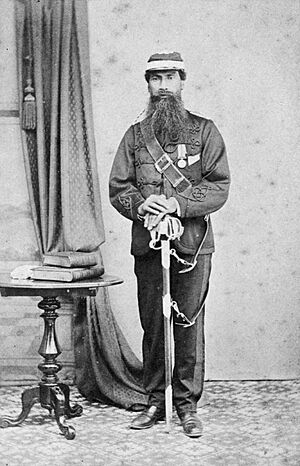Te Keepa Te Rangihiwinui facts for kids
Quick facts for kids
Te Keepa Te Rangihiwinui
NZC
|
|
|---|---|
 |
|
| Nickname(s) | Major Kemp |
| Born | near Opiki, New Zealand |
| Died | 15 April 1898 Putiki, New Zealand |
| Buried |
Putiki Urupa
|
| Allegiance | British Empire |
| Years of service | 1864–1872 |
| Rank | Major |
| Unit |
|
| Battles/wars | New Zealand War
|
| Awards | New Zealand War Medal |
Te Keepa Te Rangihiwinui (died 15 April 1898) was an important Māori military leader. He was a strong supporter of the government during the New Zealand Wars. People knew him by several names, including Te Rangihiwinui, Te Keepa, Meiha Keepa, Major Keepa, or Major Kemp.
Contents
Early Life and Beginnings
Te Keepa Te Rangihiwinui was born around the early 1820s near Opiki. His father, Mahuera Paki Tanguru-o-te-rangi, was a leader of the Muaūpoko iwi (tribe). His mother, Rere-ō-maki, was the sister of Hori Kingi Te Anaua, a leader from the Te Āti Haunui-a-Pāpārangi tribe.
When Te Keepa was young, his tribe faced threats from other tribes like the Ngāti Toa. His father supported the New Zealand Company settlement in Whanganui. He even worked as a constable, helping to keep the peace. In 1848, Te Keepa himself became a constable. He helped carry mail between Wellington and the Taranaki region.
Fighting in the New Zealand Wars
Defending Whanganui
In 1864, some Māori tribes on the Upper Whanganui River adopted a new religion called Pai Mārire. They planned to attack Whanganui town. Te Keepa led the tribes from the lower river to protect the town. This led to the Battle of Moutoa Island on May 14, 1864. Te Keepa's forces won a big victory against the Pai Mārire fighters.
This battle marked the start of six years of fighting for Te Keepa. He always fought alongside the government forces, often working with Captain Thomas McDonnell.
Key Battles and Campaigns
In February 1865, Te Keepa and his Māori warriors attacked Ohoutahi Pa, a strong Pai Mārire fort. After a missionary was killed, Te Keepa and his men traveled to Opotiki to help. They soon returned to Taranaki. There, they helped capture Wereroa Pa and then rescued people at Pipiriki.
Te Keepa slowly built his own group of about 100 to 200 warriors. The government paid these men, but their loyalty was to Te Keepa. They respected his mana (spiritual power and authority) as a fighting chief.
Leading Against Titokowaru
In 1868, Te Keepa and his men fought in Titokowaru's War. Te Keepa bravely led the retreat from Te Ngutu o Te Manu after government forces were defeated. He did the same after the Battle of Moturoa. Later, Te Keepa led the chase after Tītokowaru left his fort at Tauranga Ika. This was a special moment because British soldiers and officers served under a Māori commander for the first time. By this point, Te Keepa had been promoted to the rank of Major.
Chasing Te Kooti
The Hunt for Te Kooti
After Titokowaru was no longer a threat, Te Keepa and his men moved to the East Coast. Their new mission was to chase Te Kooti, another Māori leader. Te Keepa's reputation was so strong that the Battle of Te Pōrere near Tongariro was delayed. Everyone waited for Te Keepa and his men to arrive. They marched through snowstorms and volcanic eruptions to get there.
The final hunt for Te Kooti through the Ureweras was mostly led by Te Keepa and another Māori war leader, Ropata Wahawaha. Te Keepa and his men returned home to Whanganui in 1871.
Honors and Awards
Over the next few years, Te Keepa received many awards for his bravery and service:
- The Queen's Sword of Honour in 1870.
- The New Zealand Cross in 1874.
- The New Zealand War Medal in 1876.
Later Life and Legacy
Protecting Māori Land
In 1871, Te Keepa became a land purchase officer in Whanganui. He saw this as a chance to fix past problems. He wanted to help his people get back land they had lost. This almost caused new conflicts between tribes. Te Keepa even threatened to call on his warriors if the government did not support his decisions. There were some small fights, but in the end, his efforts paid off.
In 1880, Te Keepa created a Māori trust. This trust aimed to protect Māori land from being bought by European settlers. A large area of inland Wanganui was declared off-limits to Europeans. This made the government uneasy, but Te Keepa's large group of loyal warriors meant they had to be careful. He also had support from some government members, like the Native Minister, John Ballance.
Political Involvement
Te Keepa also tried to enter politics. He ran for the Western Maori seat in the New Zealand elections several times. He came second in the 1871 election and again in the 1876 election. He also ran in 1884, coming second out of eight candidates.
Working for Unity
In his later years, Te Keepa worked to unite Māori tribes. He joined the Te Kotahitanga (unity of purpose) movement. This movement wanted the government to follow the rules of the Treaty of Waitangi. In a speech in March 1889, he asked the government to work with Te Kotahitanga, but they refused.
Te Keepa Te Rangihiwinui passed away at Putiki, near Whanganui, on April 15, 1898.


